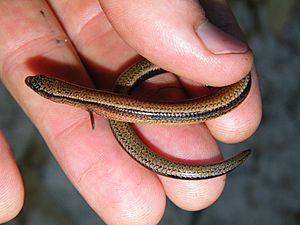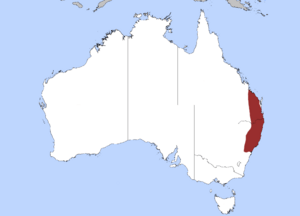Yellow-bellied three-toed skink facts for kids
Quick facts for kids Three-toed skink |
|
|---|---|
 |
|
| Conservation status | |
| Scientific classification | |
| Genus: |
Saiphos
|
| Species: |
equalis
|
 |
|
| Where the Yellow-bellied three-toed Skink lives | |
The three-toed skink, also known as the yellow-bellied three-toed skink, is a type of skink that lives in eastern Australia. It's special because it's the only species in its group, called Saiphos. This lizard is super interesting to scientists because it can have babies in two different ways: by laying eggs or by giving birth to live young!
Contents
About the Three-toed Skink
The three-toed skink can grow to about 18 cm (7.1 in) long, including its tail. It has a brown back and a bright orange belly. This skink is active at night, which means it's a nocturnal animal. It likes to eat insects.
Who Named This Skink?
The three-toed skink was first described by a British zoologist named John Edward Gray in 1825. He first called it Seps equalis. Later, in 1831, he decided it needed its own special group and named that group Saiphos. Today, Saiphos equalis is the only member of the Saiphos group. It belongs to the larger skink family, called Scincidae.
Where Do They Live?
You can find Saiphos equalis commonly in the eastern parts of Australia, especially in New South Wales and Queensland.
Reproduction and Life Cycle
One of the most amazing things about the three-toed skink is how it has babies. Some populations of these skinks lay eggs, while others give birth to live young. There are even some groups that do a mix of both!
- Egg-laying skinks: Some skinks, especially those living in coastal areas, lay eggs. These eggs can take about 15 days to hatch.
- Live-birth skinks: Skinks living in colder mountain areas usually give birth to live, fully formed babies. This means the babies develop inside the mother and are born ready to go!
- Mixed-style skinks: Some populations are in between. They lay eggs, but the eggs hatch very quickly, sometimes in just about 5 days. This is because the babies are already quite developed inside the egg before it's laid.
Scientists have studied these skinks to understand why they have different ways of having babies. They found that skinks living high up in the mountains (over 1,000 m (3,300 ft)) in north-eastern New South Wales almost always give birth to live young. But skinks in lower areas of New South Wales might lay eggs that hatch quickly. The skinks in the northernmost coastal parts of New South Wales lay eggs that take a bit longer to hatch and have thicker shells.
In 2019, something super cool happened! Researchers from the University of Sydney saw a female three-toed skink do something never seen before in a vertebrate (an animal with a backbone). She laid eggs and gave birth to live young from the same pregnancy! This shows just how unique and adaptable these amazing lizards are.


